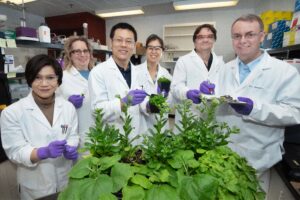Professional Communication
Speaking about your research with fellow scientists can be tricky and stressful. Figuring out the correct level of detail while also making your presentation, paper or proposal interesting and engaging can be difficult to balance.
Here, we have some tips and tools for scientific writing and presenting, as well as networking with other scientists, to help you navigate the professional realm of science communication.
Networking
One of the main reasons for attending a scientific conference is to network with members of the STEM community that work in your field. This can be intimidating, especially for early-career scientists and students.
Here are some tips to help you overcome the trepidation you may feel when networking at a conference:
 Choose a conference that is right for you. While a large conference has its benefits, and lots of important scientists will be there, sometimes a smaller conference in a more specific field will lead to more meaningful interactions.
Choose a conference that is right for you. While a large conference has its benefits, and lots of important scientists will be there, sometimes a smaller conference in a more specific field will lead to more meaningful interactions.- Do your homework! Check out the program ahead of time, make a list of the presentations you don’t want to miss and the people you want to connect with.
- Have your elevator pitch ready. Everyone will ask you what you study— you’ll be much more confident if you have a great answer! Here are some best practices for science communication and crafting an elevator pitch.
- Make sure to exchange information with the people you meet, and actually follow up with them after the conference is over.
- Schedule time to relax and have fun!
Here are some additional resources on best strategies for attending a conference:
- How to make the most of a scientific conference
- A review paper on maximizing the conference experience
Attending a Virtual Conference
Currently, lots of conferences have gone virtual. Here is a run-down on the pros and cons of virtual conferences, and why you should attend one. However, it can be a challenge to get as much interaction out of a virtual conference.
Here are some tips to get the most out of a virtual conference.
Oral Presentations
Giving a talk at a conference is one of the best ways to disseminate your research to your community and to promote interest in your work. There are a few things to keep in mind when creating an oral presentation:
- Observe the time limits!
- Rehearse your talk. This will ease your nerves and ensure that your talk will be timely.
- Add citations to anything on your slides that you did not create yourself.
- Be thoughtful about how you craft your narrative and your graphics. Some general rules of thumb:
– Limit yourself to one main point per slide. Overcrowding your slides with text and graphics can make it confusing and difficult to interpret.
– Try to use similar graphics throughout the talk.
– Distill your message down to a main narrative, and try not to digress from that.
 Here are some additional tips on how to make an oral presentation.
Here are some additional tips on how to make an oral presentation.
If you are attending a virtual conference, here are some tips on how to craft a virtual talk.
And, if you are leading a panel discussion, here is some information on best practices.
Poster Presentations
Poster presentations can be a fantastic way to present your work while also networking at a conference. But how to create a great poster? Here are some general rules of thumb:
- Poster presentations allow you to present your research in a more one-on-one format, and you can often have some meaningful conversations with interested scientists. Have a quick (under 5 minute) explanation of your project ready, then allow your audience to guide the conversation with their questions.
- Good, clear figures are key. It is great to have a central figure to point to that explains your work in its entirety.
- Don’t rely on text. You will most likely be standing in front of your poster for most of the session and can explain your key points. Consider having a QR code that leads to a link with more information on your poster, if you would like to have it in writing for your audience without cluttering your poster with text.
A traditional scientific poster follows the template of a research paper, with sections labelled “Introduction/Background,” “Methods,”Results” and “Discussion/Conclusions.” You can make this using a variety of software, including Microsoft Powerpoint and Adobe InDesign. Here is a list of resources for best practices for a traditional scientific research poster, including some templates:
 CCNY Library Guide to Poster Presentations
CCNY Library Guide to Poster Presentations- “The Scientist’s Guide to Poster Design” by Dr. Katie Everson
There is some movement among researchers to move away from this traditional poster design, toward a design that has a focus on graphics with the main message heavily emphasized, and additional information available for those who are particularly interested. Here is a video describing this type of poster, and the benefits of this type of communication strategy.
Here are some additional resources on this type of poster, including opinions on either side of this movement:
 LinkedIn is a social media website specifically for making and maintaining professional connections. Many industries use this website as a recruiting tool. Here are some resources to help build your LinkedIn profile and network:
LinkedIn is a social media website specifically for making and maintaining professional connections. Many industries use this website as a recruiting tool. Here are some resources to help build your LinkedIn profile and network:
Science Twitter
 Lots of scientists interact with each other on twitter, and this can be a great way to get updates on scientists you work with or would like to work with one day. Here are some tips on how to get started as a scientist on twitter.
Lots of scientists interact with each other on twitter, and this can be a great way to get updates on scientists you work with or would like to work with one day. Here are some tips on how to get started as a scientist on twitter.
Joining a Peer Community
 No matter where you live, there are Networking groups that you can join. Meetup.com has lots of options, but if you aren’t finding what you are looking for, start your own!
No matter where you live, there are Networking groups that you can join. Meetup.com has lots of options, but if you aren’t finding what you are looking for, start your own!
 From the Office of Career Planning & Professional Development, a comprehensive guide on how to find and apply for grants
From the Office of Career Planning & Professional Development, a comprehensive guide on how to find and apply for grants- A CUNY Graduate Center guide to preparing your proposal
- Grant-writing tips for graduate students
- A quick but broadly applicable template for writing a grant proposal
- NSF-specific tips for graduate students
Some grants require a professional biosketch. Here is a guide to writing one.
Here is a comprehensive guide from the Office of Career Planning & Professional Development, with general writing tips and several specific guides.
Here is a link to resources from the CUNY GC Writing Center, which has guides for writing a manuscript, an abstract, and beyond.
One thing to keep in mind is that more jargon is not always better. Here is a research article highlighting how scientific papers with more jargon get cited less by the STEM community. (Here is the NYTimes summary of that article).
 Most scientific papers have more than one author. Collaboration in science is key, but can be tricky to navigate. Here are some resources and tips on how to make your collaborations as seamless as possible:
Most scientific papers have more than one author. Collaboration in science is key, but can be tricky to navigate. Here are some resources and tips on how to make your collaborations as seamless as possible:
- A guide from Science magazine on how to collaborate
- A perspective paper on the importance of transparency in authorship
- Strategies for effective interdisciplinary collaborations
- 10 simple rules for effective collaboration
Working with scientist within different disciplines can be a challenge because specific fields have their own jargon (exclusive language). Learning how to communicate on an interdisciplinary team is an invaluable skill. Here you can find guidance on improving interdisciplinary collaboration and team communication.
The “Collaboration Team Science Guide” covers topics like self preparation, leading and building a research team, and team communication.
Academic discoveries are often hard to translate into industrial solutions. Basic discoveries must be attractively packaged and presented in a digestible form that helps industry professionals understand how it fits into a current or emerging market and how it can be translated into end-user products. Learning how to communicate science in industry friendly language is essential not only to pushing your research forward to the R&D stage, but also in making you an attractive hire. Private industry is on track to become the largest employer of STEM researchers, according the the National Science Foundation, so knowing how to communicate your academic success to drive industry goals is also critical to your future. These resources can help.
Sharon Gill, a research officer at the IN-PART Sheffield office, offers tips on communicating academic breakthroughs to R&D (Research & Development) professionals in industry.
Building Relationships
Check out these tips from Tavis Ezell, Business Development Director for the ASRC Sensor CAT, on how to build relationships with STEM industry leadership:
Find Connections
- Research the companies, jobs, and employee titles that seem of interest.
- Do not let yourself get locked into thinking that these need to relate only to your research area or the title of your degree. The new job world highly values interdisciplinary thinking.
- Take the research you have done and start connecting with people within a company that have a position that interests you. Attend events (virtual or in-person) where people in the company or field you are interested in are attending or speaking. Use your research and organically connect with people and start connecting the dots until you find your way into conversation about a job opportunity.
- Strong connections happen through effective communication. You’re looking to share your skills and experience working together and fitting into a team of people with similar intentions. Learn the problem(s) this company is trying to solve and how your skillset and experiences make you uniquely positioned to solve it.
Communicate Your Research & Experience
- Your research may be very important to you and your achievements praiseworthy, but the people with whom you are networking or interviewing may not care. They care about the problem that they’ve been charged with solving and whether you can help achieve the solution. Approach any conversation from this perspective.
- Think outside the box when communicating your experience. You may have not had the opportunity to do an internship or work within private industry, but you can use your understanding gained from research about the company and their problem(s) to guide you.
- Your experiences solving complex problems in a lab in a particular field are much more widely applicable than you may realize. Think about how those experiences apply to major themes that future employer cares about. What were those problems? How can you relate them to company and job role for which you are applying?
Emphasize Transferable Skills
- Knowledge in a particular field is important to relate, but also consider other skills you have gained and how they relate to a company and/or its lab environment. What instrumentation have you learned to use or been exposed to during your academic career?
- Always relate experiences based on how you solved problems together as a team. Did you collaborate with lab groups in other departments? Universities? Across the planet? Great! Employers want to hear how you navigate such challenges.
- Employers look for diverse experiences. It helps them understand how you can work together and adapt to ever-changing problems.
- You have studied in NYC with colleagues from all over the world and worked with scientists from diverse backgrounds? This is an experience in diversity and a benefit of learning science as a CUNY student — talk about it!
Continue Networking
- The more conversations and connections you start to make, the better. Not every one will lead to a job opportunity, nor will every interview be successful.
- Networking takes a lot of effort, but will eventually start to pay off once you build relationships with people. Continue reaching out and reminding people who you are based on your interest in them and what they are doing.
- Not every job application leads to an interview. Move on to the next, and the next, until you get some traction. Remind yourself that your creative, hard work to get the attention necessary for that interview will all pay off once they meet you and hear what makes you a great candidate!
Applying to Graduate School & Postdoc Positions
Applying to graduate school can be a confusing, stressful and inequitable process, full of unwritten rules. Here are some guides to help you navigate it:
- Here is a guide from the Office of Career Planning & Professional Development on how and why to apply to a PhD program, including specific guides to different aspects of the admissions process.
- Here is a guide from Science magazine on how to make your applications successful.
 A postdoctoral fellowship is a common first step after completing a PhD. Most PhDs complete more than one postdoctoral fellowship before landing a more permanent position. The application process can be difficult, especially as you are required to do so while completing your dissertation! Here is a guide from the Office of Career Planning & Professional Development with some resources and opportunities, including several different types of postdoctoral fellowships.
A postdoctoral fellowship is a common first step after completing a PhD. Most PhDs complete more than one postdoctoral fellowship before landing a more permanent position. The application process can be difficult, especially as you are required to do so while completing your dissertation! Here is a guide from the Office of Career Planning & Professional Development with some resources and opportunities, including several different types of postdoctoral fellowships.
Here is a blog post that describes how to demystify the process by networking while in graduate school.
Writing a CV
A CV is like a resume, but much more comprehensive and is more widely used in Academia.
Here is a guide to writing a CV, along with a few sample templates.
Here is a guide describing the main differences between a CV and a traditional resume.
 A personal website is an easy way to direct people to information about your work and your interests, and to connect with other scientists and professionals. Here is a guide to building one.
A personal website is an easy way to direct people to information about your work and your interests, and to connect with other scientists and professionals. Here is a guide to building one.
Often, labs will have their own websites with overarching research themes, open positions, and bios about the members. If your lab doesn’t have one, it could be beneficial to everyone to build one. Here is a guide to making a lab website.


